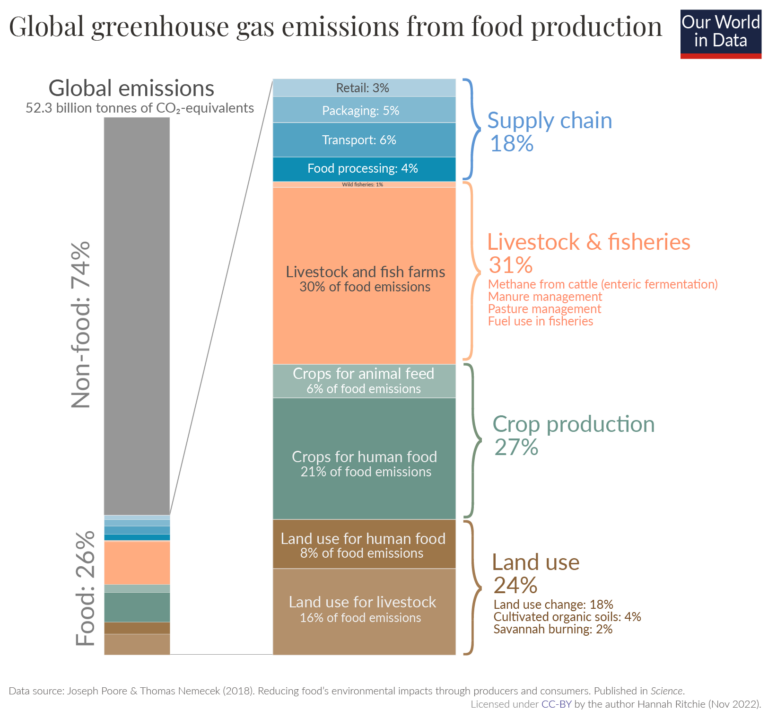When it comes to tackling climate change, the focus tends to be on ‘clean energy’ solutions – the deployment of renewable or nuclear energy; improvements in energy efficiency; or transition to low-carbon transport. Indeed, energy, whether in the form of electricity, heat, transport or industrial processes, account for the majority – 76% – of greenhouse gas (GHG) emissions.1
But the global food system, which encompasses production, and post-farm process such as processing, and distribution is also a key contributor to emissions. And it’s a problem for which we don’t yet have viable technological solutions.
The visualization shown here – based on data from the meta-analysis by Joseph Poore and Thomas Nemecek (2018), published in Science – summarizes food’s share of total emissions and breaks it down by source.2
Food is responsible for approximately 26% of global GHG emissions.
There are four key elements to consider when trying to quantify food GHG emissions. These are shown by category in the visualization:
Livestock & fisheries account for 31% of food emissions.
Livestock – animals raised for meat, dairy, eggs and seafood production – contribute to emissions in several ways. Ruminant livestock – mainly cattle – for example, produce methane through their digestive processes (in a process known as ‘enteric fermentation’). Manure management, pasture management, and fuel consumption from fishing vessels also fall into this category. This 31% of emissions relates to on-farm ‘production’ emissions only: it does not include land use change or supply chain emissions from the production of crops for animal feed: these figures are included separately in the other categories.
Crop production accounts for 27% of food emissions.
21% of food’s emissions comes from crop production for direct human consumption, and 6% comes from the production of animal feed. They are the direct emissions which result from agricultural production – this includes elements such as the release of nitrous oxide from the application of fertilizers and manure; methane emissions from rice production; and carbon dioxide from agricultural machinery.
Land use accounts for 24% of food emissions.
Twice as many emissions result from land use for livestock (16%) as for crops for human consumption (8%).3Agricultural expansion results in the conversion of forests, grasslands and other carbon ‘sinks’ into cropland or pasture resulting in carbon dioxide emissions. ‘Land use’ here is the sum of land use change, savannah burning and organic soil cultivation (plowing and overturning of soils).
Supply chains account for 18% of food emissions.
Food processing (converting produce from the farm into final products), transport, packaging and retail all require energy and resource inputs. Many assume that eating local is key to a low-carbon diet, however, transport emissions are often a very small percentage of food’s total emissions – only 6% globally. Whilst supply chain emissions may seem high, at 18%, it’s essential for reducing emissions by preventing food waste. Food waste emissions are large: one-quarter of emissions (3.3 billion tonnes of CO2eq) from food production ends up as wastage either from supply chain losses or consumers. Durable packaging, refrigeration and food processing can all help to prevent food waste. For example, wastage of processed fruit and vegetables is ~14% lower than fresh, and 8% lower for seafood.4
Reducing emissions from food production will be one of our greatest challenges in the coming decades. Unlike many aspects of energy production where viable opportunities for upscaling low-carbon energy – renewable or nuclear energy – are available, the ways in which we can decarbonize agriculture are less clear. We need inputs such as fertilizers to meet growing food demands, and we can’t stop cattle from producing methane. We will need a menu of solutions: changes to diets; food waste reduction; improvements in agricultural efficiency; and technologies that make low-carbon food alternatives scalable and affordable.


